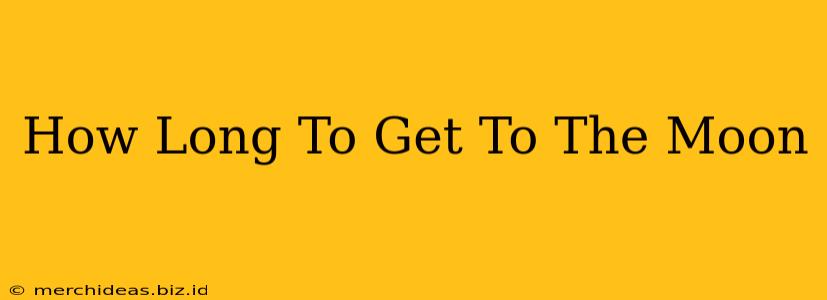The moon. Our celestial neighbor, a captivating sphere of craters, mountains, and valleys. But how long does it actually take to get there? The answer, as with most things in space, isn't straightforward. It depends on several factors, including the chosen trajectory and the power of the spacecraft.
The Apollo Missions: A Historical Perspective
The Apollo missions, which successfully landed twelve humans on the moon between 1969 and 1972, provide a good benchmark. These missions typically took around three days to reach the moon. This wasn't a constant speed journey, however. The spacecraft underwent several phases:
Stages of the Lunar Journey:
- Earth Orbit: The spacecraft first entered Earth's orbit to achieve the necessary speed and trajectory.
- Translunar Injection (TLI): A powerful engine burn propelled the spacecraft out of Earth's gravitational pull and onto a path toward the moon.
- Mid-Course Corrections: Slight adjustments to the trajectory were made en route to ensure a precise lunar orbit insertion.
- Lunar Orbit Insertion (LOI): Another engine burn slowed the spacecraft sufficiently to be captured by the moon's gravity, allowing it to enter lunar orbit.
- Lunar Descent and Ascent: The lunar module separated from the command module, descended to the lunar surface, and later ascended back to rendezvous with the command module.
- Trans-Earth Injection (TEI): Finally, an engine burn propelled the spacecraft back towards Earth.
Factors Affecting Travel Time
While three days was the typical Apollo timeframe, several factors could influence the travel duration:
- Launch Window: The alignment of the Earth and the moon significantly impacts the amount of energy needed for the journey, hence affecting travel time. Optimal launch windows minimize fuel consumption and travel time.
- Spacecraft Propulsion: More powerful propulsion systems could shorten the journey considerably. Advanced propulsion technologies under development, like ion propulsion, promise significantly faster travel times.
- Mission Trajectory: Different trajectories, such as direct ascent or free-return trajectories, can affect the overall travel time. Direct ascent minimizes the time spent in orbit, but can demand more fuel. Free-return trajectories inherently offer a safety net in case the engine malfunctions.
Future Lunar Missions: A Look Ahead
With renewed interest in lunar exploration, future missions may employ different techniques to reach the moon faster and more efficiently. These could include:
- Space-Based Fuel Depots: Establishing fuel depots in orbit could reduce the amount of fuel needed for the journey, allowing for faster trips and heavier payloads.
- Improved Propulsion Systems: Advanced propulsion methods could significantly cut down travel times, potentially getting to the moon in a matter of hours instead of days.
Conclusion: The Ever-Changing Journey to the Moon
The time it takes to get to the moon isn't a fixed number. While the Apollo missions took roughly three days, future missions could drastically reduce this timeframe thanks to technological advancements and innovative approaches. The journey to the moon, a feat of human ingenuity, continues to evolve, promising ever more efficient and faster travel times in the years to come.
